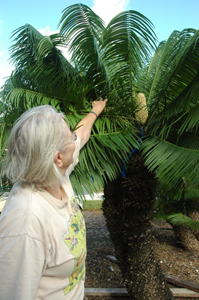A great deal of specialized work goes into pollinating plants at MBC.
Loss of natural habitat and unscrupulous poaching puts a big pressure on cycads. Cycad seeds produced at MBC are shared with other botanical gardens, educational institutions, and scientific researchers. Collectors have a chance to purchase the rare seeds legally, and as the supply expands poaching could lessen.
So, for National Pollinator Week, MBC would like to highlight the work of Judy Kay, MBC Seedbank Coordinator. Here, Judy shares her field notes on managing the cycad collections for seed production, and some observations on palms and other collections:
“For the last ten years, the cycads have been quite consistently cyclic. Encephalartos male cones shed pollen August–May. The females are receptive August–December, and disperse seeds January–March.
Cold temperatures only affect Encephalartos ferox females. They will close up immediately if receptive, and if already pollinated they may abort the seeds. I always leave an unpollinated control cone to see if any new pollinators have been introduced. None have appeared so far.
Cycas has had many open pollinated seeds from 2000–2010. The male cones shed pollen April–June. The females are receptive April–June and the seeds are harvested August–November. This year the long cold spell had a very dramatic effect on the female Cycas panzhihuaensis. This rare Cycas is a cold hardy cycad, which grows in high altitudes in China. Since 2002, we have had many male cones but only two females. Now we have over 13 female cones, including one plant exhibiting five female cones.
Dioon spinulosum and D. mejiae had a few open pollinated viable seeds each year from 2000-2010. They produce pollen, receptive cones and seeds at various times during the year. Since it takes two-three years for the seeds to mature, plants will often have several hand pollinated cones from different years. The seeds are usually already sprouted when the cone begins to disarticulate.
Microcycas calocoma has the most efficient schedule. Pollen and receptive cones both exist August–September. Seeds are harvested the following June–July. No open pollinations recorded.
Ceratozamia have pollen February–May and receptive cones May–July. Seeds are harvested the next January–May with no open pollinations.
Zamia, except for the Zamia inermis, are usually pollinated by a local pollinator. (See MBC Newsletter Spring 2007 for pollinator exclusion experiments). Successful palm pollinations include Nypa fruiticans, Bismarckia nobilis, Pseudophoenix vinifera, and Allagoptera arenaria. Fruit and flowering trees pollinated include Brownea capitella and Butea monosperma. MBC collaborated with Fairchild Tropical Botanical Garden and The Kampong to cross pollinate Couroupita guianensis, sharing fruits and seeds.”
During Judy’s time at MBC, she has generously shared information, records, pollen, and demonstrated her methods to visiting experts from many botanic gardens. Judy states, “I’m always happy to answer any questions or give demonstrations of pollination techniques–The more rare seeds we can produce, the less rare they will be!”

